捷径英语教(学)案unit4(上)
- 格式:doc
- 大小:51.50 KB
- 文档页数:8
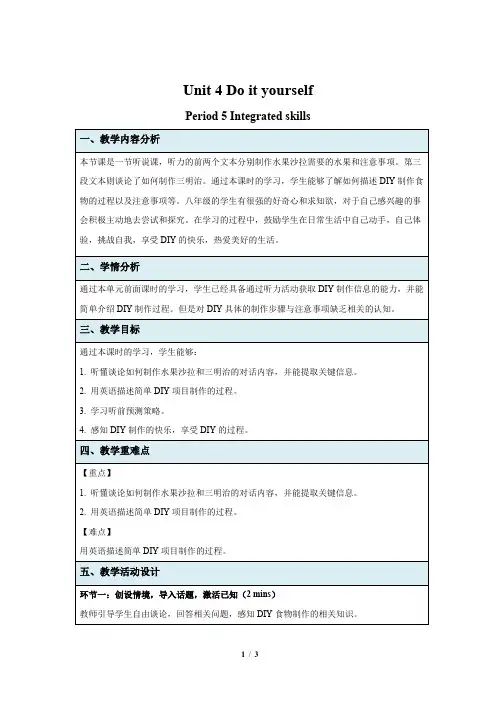
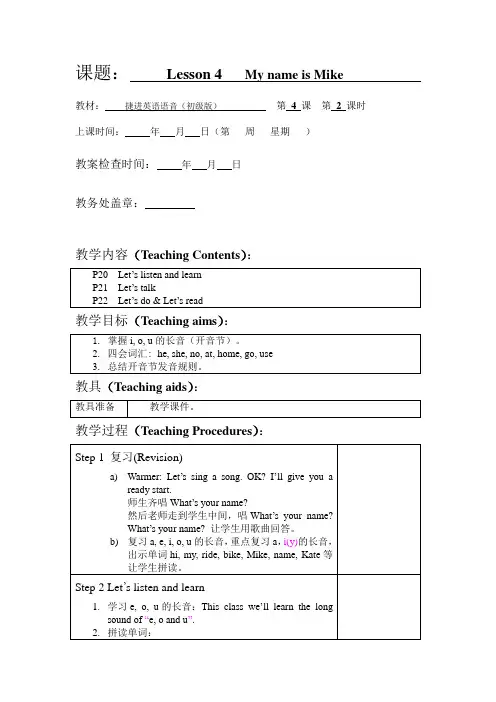

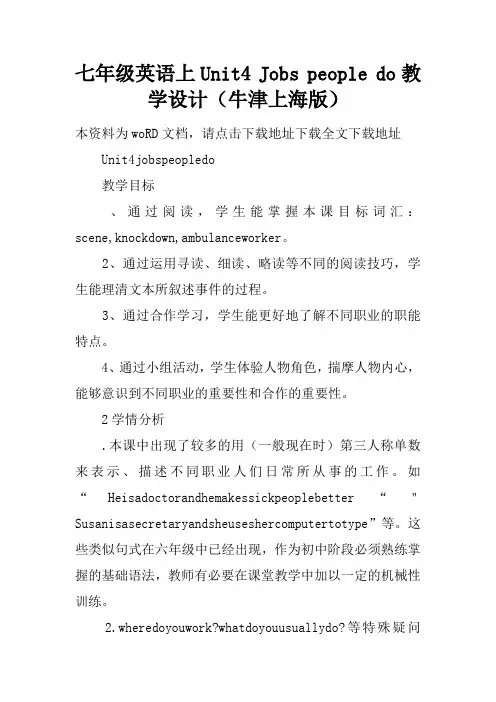
七年级英语上Unit4 Jobs people do教学设计(牛津上海版)本资料为woRD文档,请点击下载地址下载全文下载地址Unit4jobspeopledo教学目标、通过阅读,学生能掌握本课目标词汇:scene,knockdown,ambulanceworker。
2、通过运用寻读、细读、略读等不同的阅读技巧,学生能理清文本所叙述事件的过程。
3、通过合作学习,学生能更好地了解不同职业的职能特点。
4、通过小组活动,学生体验人物角色,揣摩人物内心,能够意识到不同职业的重要性和合作的重要性。
2学情分析.本课中出现了较多的用(一般现在时)第三人称单数来表示、描述不同职业人们日常所从事的工作。
如“Heisadoctorandhemakessickpeoplebetter“"Susanisasecretaryandsheuseshercomputertotype”等。
这些类似句式在六年级中已经出现,作为初中阶段必须熟练掌握的基础语法,教师有必要在课堂教学中加以一定的机械性训练。
2.wheredoyouwork?whatdoyouusuallydo?等特殊疑问句式在课文中出现用来引导学生对职业内涵的进一步阐述。
3重点难点学习重点:、了解不同职业的工作职责2、理清事件发展的逻辑顺序3、感悟各种职业的重要性以及体验分工合作的重要性学习难点:、准确使用一般过去时描述过去发生的行为2、运用合适的阅读技能4教学过程【导入】Pre-reading activity)watchavideoclipandhaveafriendlytalkaboutit.2)Talkaboutthepictureoftheaccident.通过欣赏一首jobssong,激发学生兴趣并引出主题。
对事故图片进行简单讨论,教授课文目标词汇:knockdown,scene。
【讲授】The accident)Scanthefirstparagraphtofillinthetable.2)Listentoaphonecallandmakeanewonetoreporttheaccide nt.通过寻读,填表格,了解事件发生起因;并通过打报警电话,在真实的语境中对事故有更好的了解。
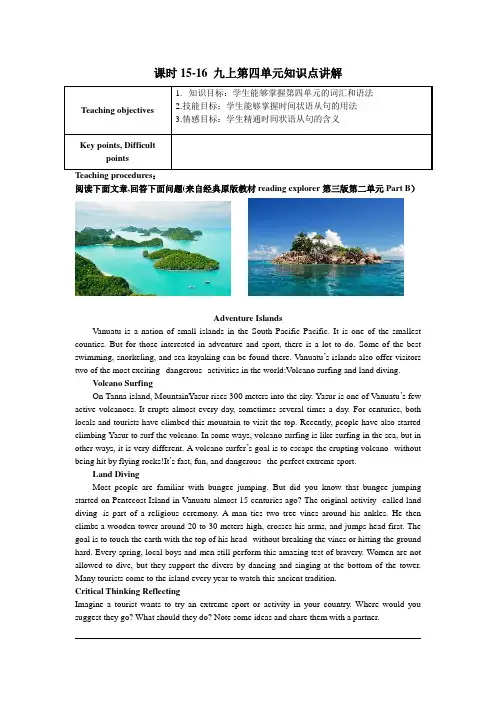
课时15-16 九上第四单元知识点讲解Teaching objectives 1.知识目标:学生能够掌握第四单元的词汇和语法2.技能目标:学生能够掌握时间状语从句的用法3.情感目标:学生精通时间状语从句的含义Key points, DifficultpointsTeaching procedures:阅读下面文章,回答下面问题(来自经典原版教材reading explorer第三版第二单元Part B)Adventure IslandsVanuatu is a nation of small islands in the South Pacific Pacific. It is one of the smallest counties. But for those interested in adventure and sport, there is a lot to do. Some of the best swimming, snorkeling, and sea kayaking can be found there. Vanuatu’s islands also offer visitors two of the most exciting--dangerous--activities in the world:Volcano surfing and land diving.Volcano SurfingOn Tanna island, MountainYasur rises 300 meters into the sky. Yasur is one of Vanuatu’s few active volcanoes. It erupts almost every day, sometimes several times a day. For centuries, both locals and tourists have climbed this mountain to visit the top. Recently, people have also started climbing Yasur to surf the volcano. In some ways, volcano surfing is like surfing in the sea, but in other ways, it is very different. A volcano surfer’s goal is to escape the erupting volcano--without being hit by flying rocks!It’s fast, fun, and dangerous--the perfect extreme sport.Land DivingMost people are familiar with bungee jumping. But did you know that bungee jumping started on Pentecost Island in Vanuatu almost 15 centuries ago? The original activity--called land diving--is part of a religious ceremony. A man ties two tree vines around his ankles. He then climbs a wooden tower around 20 to 30 meters high, crosses his arms, and jumps head first. The goal is to touch the earth with the top of his head--without breaking the vines or hitting the ground hard. Every spring, local boys and men still perform this amazing test of bravery. Women are not allowed to dive, but they support the divers by dancing and singing at the bottom of the tower. Many tourists come to the island every year to watch this ancient tradition.Critical Thinking ReflectingImagine a tourist wants to try an extreme sport or activity in your country. Where would you suggest they go? What should they do? Note some ideas and share them with a partner.Ⅱ.Language points:知识点01:What's on your mind,Eddie? 你在想什么呢,埃迪?解析:on one's mind意为“挂在心上;惦念”,其中的mind是可数名词,意为“头脑,思想”。
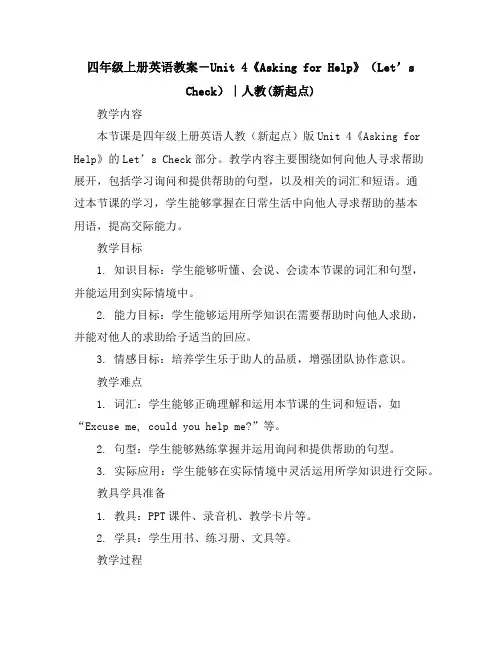
四年级上册英语教案-Unit 4《Asking for Help》(Let’sCheck)|人教(新起点)教学内容本节课是四年级上册英语人教(新起点)版Unit 4《Asking for Help》的Let’s Check部分。
教学内容主要围绕如何向他人寻求帮助展开,包括学习询问和提供帮助的句型,以及相关的词汇和短语。
通过本节课的学习,学生能够掌握在日常生活中向他人寻求帮助的基本用语,提高交际能力。
教学目标1. 知识目标:学生能够听懂、会说、会读本节课的词汇和句型,并能运用到实际情境中。
2. 能力目标:学生能够运用所学知识在需要帮助时向他人求助,并能对他人的求助给予适当的回应。
3. 情感目标:培养学生乐于助人的品质,增强团队协作意识。
教学难点1. 词汇:学生能够正确理解和运用本节课的生词和短语,如“Excuse me, could you help me?”等。
2. 句型:学生能够熟练掌握并运用询问和提供帮助的句型。
3. 实际应用:学生能够在实际情境中灵活运用所学知识进行交际。
教具学具准备1. 教具:PPT课件、录音机、教学卡片等。
2. 学具:学生用书、练习册、文具等。
教学过程1. 导入:通过图片或视频引导学生复习与寻求帮助相关的词汇和句型,激发学生的学习兴趣。
2. 新授:利用PPT课件呈现本节课的词汇和句型,引导学生跟读并模仿,确保学生正确理解和掌握。
3. 练习:设计角色扮演、小组讨论等环节,让学生在模拟情境中运用所学知识进行练习,提高交际能力。
4. 巩固:通过游戏、竞赛等形式,巩固所学知识,检测学生的学习效果。
板书设计1. Unit 4 Asking for Help(Let’s Check)2. 关键词汇和句型:列出本节课的重点词汇和句型,方便学生回顾和复习。
作业设计1. 书面作业:完成练习册上的相关练习,巩固所学知识。
2. 口头作业:与家长或同学进行角色扮演,模拟寻求帮助的情境,提高口语表达能力。

Unit 1 Opening Doors(1---2 periods)Step 1 Warm upQuestion:Why do you go to college?Teaching tips:1.Ask Ss to look at the pictures and then read the reasons.2.Ask Ss to match the pictures to the reason.3.Check the answers as a class.Step 2 Pre-Reading1.Write starting college onto the board.2. Ask Ss to think about their feelings on the first day when they startedat college and what things happened.3. Elicit ideas and write them onto the board.4. Check the answers as a class.5. Ss are asked to read the new words and expressions.Step 3 Reading For LearningA Shaky StartSs read the text individually and try to find the author’s feeling show to change. Ss try to translate the text.Language bank1. I woke up early, much earlier than I had expected.我很早就起床了,比我预料的早得多。
1) wake up: stop sleeping; to make sb stop sleeping 醒来;叫醒e.g. I didn’t wake up until I heard the alarm clock.直到听到闹钟的铃声我才醒来。
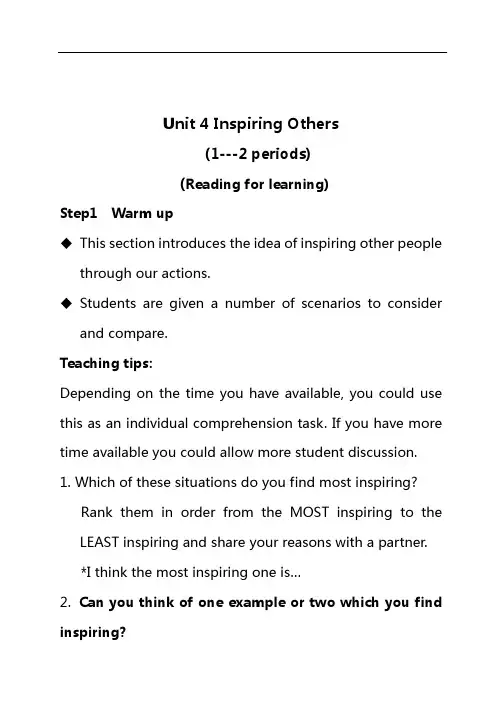
Unit 4 Inspiring Others(1---2 periods)(Reading for learning)Step1 Warm up◆This section introduces the idea of inspiring other peoplethrough our actions.◆Students are given a number of scenarios to considerand compare.Teaching tips:Depending on the time you have available, you could use this as an individual comprehension task. If you have more time available you could allow more student discussion. 1. Which of these situations do you find most inspiring?Rank them in order from the MOST inspiring to the LEAST inspiring and share your reasons with a partner.*I think the most inspiring one is…2.Can you think of one example or two which you find inspiring?A poor man adopted many orphans and brought themup on his own.Step 2 Words and phrasesTeaching tips:1. Ask Ss to look at the words and explain the meanings to Ss.2. Play the audio again and tell Ss to repeat each word as they hear it.Step 3 Reading for learningThis section starts with recognising time order. It then encourages students to think one approach to text organisation.1. Vocabulary and GrammarStudents look at word formation based on words from the text. They also practise using words related to the theme. The grammar focus revises the use of articles, focusing on the use of the articles—a/an and the.2. Beyond the TextStudents react to quotes and stories.Teaching tips:1. Ask Ss to cover the text, look at the book and listen carefully.2. Ask Ss to uncover the text. Play the tape again and tellSs to follow in their books.3. Check Ss’answers to the question above.3.1 Ask Ss to read the text again. 3.2 Ask Ss to read questions.3.3 Give Ss time to work out the answers.3.4 Check answers.Step 4 Reading and UnderstandingIn Reading and Understanding, T ask 1 of identifying the time order also checks students understanding of the main points. Task 2 and T ask 3 encourage students to summarise main ideas and to see connections between ideas within the text.Teaching tips:1. Ss should have a quick view without checking detailedunderstanding.2. Recognizing the time order (理解时间顺序)3. Ask Ss to find the answers in the texts.4. Check the answers as a class.Step 5 Vocabulary FocusStep 6 Do the related tasksUnit 4 Inspiring Others(3---4 periods)(Reading for doing )Step 1 RevisionTeaching tips:1. Review what they have learnt in the last class by asking some questions and summarizing the key points and the difficult points.2. Check the homework assigned last time.3. Asking any questions from the students.Step 2 Warm up Teaching tips:Ask Ss to Look at the pictures. Tell a partner what you think are happening in these pictures.1.Ask Ss to discuss the questions in the task in pairs.2.Ask Ss to speak out in pairs.Step 3 Reading for doingFLASH MOBS: Political Statement or Just Fun?1. Students read an article describing flash mobs.2. Students create their own flash mob.3.1 Teaching tips:1. Ask Ss to read the responses and underline keywords.2. Ask Ss to match each response to a problem in the text.3. Check the answers.Step 4 Words and phrases1. statement n.声明;述e.g. We attached no significance to her statement.2. plastic adj. 塑料的e.g. The plastic coating is easy to apply on any surface.3. flash mob快闪运动;快闪族e.g. Some young people organised a flash mob in front of the building today.Step 5 Exercises1. Do the related tasks to the passage.2. Show your response to a partner and discuss the questions.3.Select Ss to present their work.4.Check the answers.Unit 4 Inspiring Others(7---8 periods) (Audio/Video Lab)Step 1 RevisionTeaching tips:1. Review what they have learnt in the last class by asking some questions and summarizing the key points and the difficult points.2. Check the homework assigned last time.3. Asking any questions from the students.Step 2 Warm upTeaching tips:1. Students watch a video showing images of inspiring people and events:(1) listening for main ideas(2) students discuss who and what inspires them2. For each part of the video you might want to play it twice.Students might need more support with Task 4. With weaker classes, provide some phrases or sentences on the board to help them.3. Ask Ss to read the heading and look at the pictures.4. Ask Ss the question given and elicit answers.Step3 Audio/Video labTeaching tips:Listening for the main ideas in a speech1. Look at the pictures. What is happening in each one? Possible answers:In Picture B, it might inspire people to teach others and show them what they know.In Picture C, the person is caring for an elderly person. It might inspire people to look after their elders.2. Watch the video and complete the main ideas.3. Watch the video and complete the main ideas.4. Watch the video and tick the person who inspiresothers by doing the right thing.5. Watch the video again. Tick the person who inspires others by doing the right thing.Possible answersI agree with some of the advice, especially the first half. Possibly, I know I did when I was a team captain.I find my parents inspiring. They had very little and now they are quite successful.6. Listen to three speakers talking about the things they find inspiring and then match each thing to the speaker. Step 4 SpeakingTeaching tips:Ask Ss to work in groups of four and practice posting letters and parcels with the given information and the following useful expressions:。
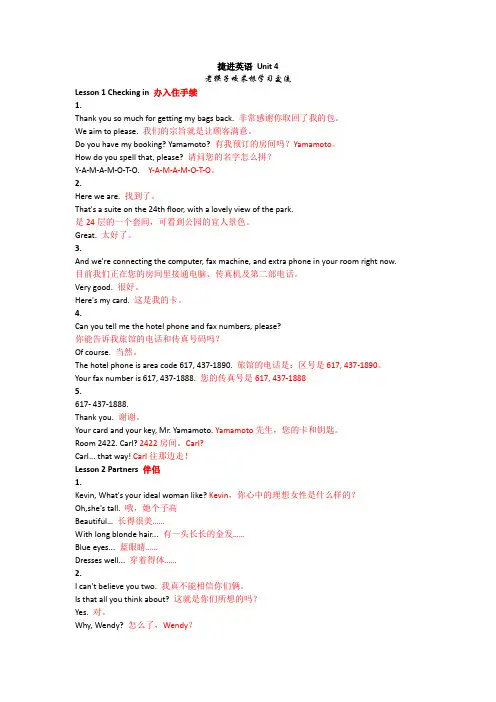
捷进英语Unit 4老猴子咬菜根学习交流Lesson 1 Checking in 办入住手续1.Thank you so much for getting my bags back. 非常感谢你取回了我的包。
We aim to please. 我们的宗旨就是让顾客满意。
Do you have my booking? Yamamoto? 有我预订的房间吗?Yamamoto。
How do you spell that, please? 请问您的名字怎么拼?Y-A-M-A-M-O-T-O. Y-A-M-A-M-O-T-O。
2.Here we are. 找到了。
That's a suite on the 24th floor, with a lovely view of the park.是24层的一个套间,可看到公园的宜人景色。
Great. 太好了。
3.And we're connecting the computer, fax machine, and extra phone in your room right now. 目前我们正在您的房间里接通电脑、传真机及第二部电话。
Very good. 很好。
Here's my card. 这是我的卡。
4.Can you tell me the hotel phone and fax numbers, please?你能告诉我旅馆的电话和传真号码吗?Of course. 当然。
The hotel phone is area code 617, 437-1890. 旅馆的电话是:区号是617, 437-1890。
Your fax number is 617, 437-1888. 您的传真号是617, 437-18885.617- 437-1888.Thank you. 谢谢。
Your card and your key, Mr. Yamamoto. Yamamoto先生,您的卡和钥匙。
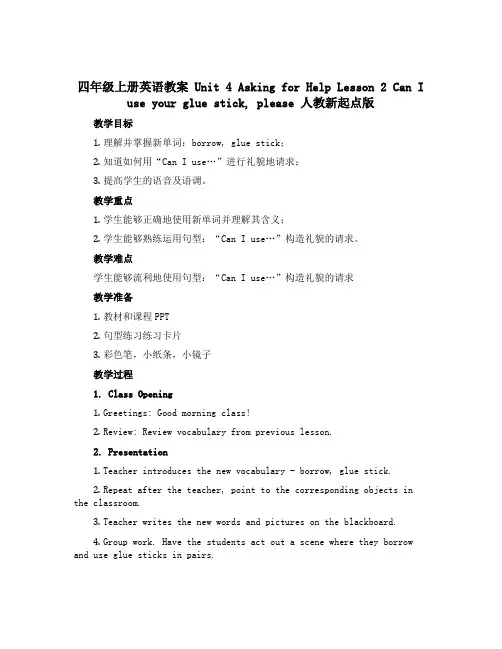
四年级上册英语教案 Unit 4 Asking for Help Lesson 2 Can I use your glue stick, please 人教新起点版教学目标1.理解并掌握新单词:borrow, glue stick;2.知道如何用“Can I use…”进行礼貌地请求;3.提高学生的语音及语调。
教学重点1.学生能够正确地使用新单词并理解其含义;2.学生能够熟练运用句型:“Can I use…”构造礼貌的请求。
教学难点学生能够流利地使用句型:“Can I use…”构造礼貌的请求教学准备1.教材和课程PPT2.句型练习练习卡片3.彩色笔,小纸条,小镜子教学过程1. Class Opening1.Greetings: Good morning class!2.Review: Review vocabulary from previous lesson.2. Presentation1.Teacher introduces the new vocabulary - borrow, glue stick.2.Repeat after the teacher, point to the corresponding objects in the classroom.3.Teacher writes the new words and pictures on the blackboard.4.Group work. Have the students act out a scene where they borrow and use glue sticks in pairs.5.Ask students to share their experiences and difficulties while borrowing and using glue.3. Practice1.Teacher repeats sentences with emphasis:。
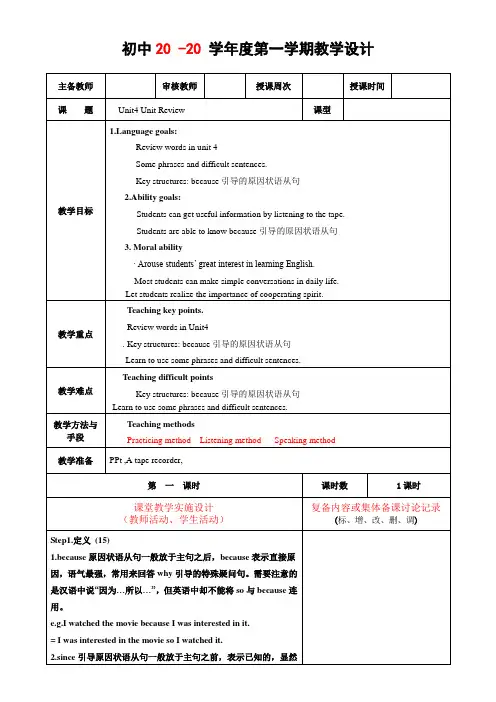
Unit 4 Inspiring Others(1---2 periods)(Reading for learning)Step1 Warm up◆This section introduces the idea of inspiring other peoplethrough our actions.◆Students are given a number of scenarios to considerand compare.Teaching tips:Depending on the time you have available, you could use this as an individual comprehension task. If you have more time available you could allow more student discussion. 1. Which of these situations do you find most inspiring?Rank them in order from the MOST inspiring to the LEAST inspiring and share your reasons with a partner.*I think the most inspiring one is…2.Can you think of one example or two which you find inspiring?A poor man adopted many orphans and brought themup on his own.Step 2 Words and phrasesTeaching tips:1. Ask Ss to look at the words and explain the meanings to Ss.2. Play the audio again and tell Ss to repeat each word as they hear it.Step 3 Reading for learningThis section starts with recognising time order. It then encourages students to think one approach to text organisation.1. Vocabulary and GrammarStudents look at word formation based on words from the text. They also practise using words related to the theme. The grammar focus revises the use of articles, focusing on the use of the articles—a/an and the.2. Beyond the TextStudents react to quotes and stories.Teaching tips:1. Ask Ss to cover the text, look at the book and listen carefully.2. Ask Ss to uncover the text. Play the tape again and tellSs to follow in their books.3. Check Ss’answers to the question above.3.1 Ask Ss to read the text again. 3.2 Ask Ss to read questions.3.3 Give Ss time to work out the answers.3.4 Check answers.Step 4 Reading and UnderstandingIn Reading and Understanding, T ask 1 of identifying the time order also checks students understanding of the main points. Task 2 and T ask 3 encourage students to summarise main ideas and to see connections between ideas within the text.Teaching tips:1. Ss should have a quick view without checking detailedunderstanding.2. Recognizing the time order (理解时间顺序)3. Ask Ss to find the answers in the texts.4. Check the answers as a class.Step 5 Vocabulary FocusStep 6 Do the related tasksUnit 4 Inspiring Others(3---4 periods)(Reading for doing )Step 1 RevisionTeaching tips:1. Review what they have learnt in the last class by asking some questions and summarizing the key points and the difficult points.2. Check the homework assigned last time.3. Asking any questions from the students.Step 2 Warm up Teaching tips:Ask Ss to Look at the pictures. Tell a partner what you think are happening in these pictures.1.Ask Ss to discuss the questions in the task in pairs.2.Ask Ss to speak out in pairs.Step 3 Reading for doingFLASH MOBS: Political Statement or Just Fun?1. Students read an article describing flash mobs.2. Students create their own flash mob.3.1 Teaching tips:1. Ask Ss to read the responses and underline keywords.2. Ask Ss to match each response to a problem in the text.3. Check the answers.Step 4 Words and phrases1. statement n.声明;陈述e.g. We attached no significance to her statement.2. plastic adj. 塑料的e.g. The plastic coating is easy to apply on any surface.3. flash mob快闪运动;快闪族e.g. Some young people organised a flash mob in front of the building today.Step 5 Exercises1. Do the related tasks to the passage.2. Show your response to a partner and discuss the questions.3.Select Ss to present their work.4.Check the answers.Unit 4 Inspiring Others(7---8 periods) (Audio/Video Lab)Step 1 RevisionTeaching tips:1. Review what they have learnt in the last class by asking some questions and summarizing the key points and the difficult points.2. Check the homework assigned last time.3. Asking any questions from the students.Step 2 Warm upTeaching tips:1. Students watch a video showing images of inspiring people and events:(1) listening for main ideas(2) students discuss who and what inspires them2. For each part of the video you might want to play it twice.Students might need more support with Task 4. With weaker classes, provide some phrases or sentences on the board to help them.3. Ask Ss to read the heading and look at the pictures.4. Ask Ss the question given and elicit answers.Step3 Audio/Video labTeaching tips:Listening for the main ideas in a speech1. Look at the pictures. What is happening in each one? Possible answers:In Picture B, it might inspire people to teach others and show them what they know.In Picture C, the person is caring for an elderly person. It might inspire people to look after their elders.2. Watch the video and complete the main ideas.3. Watch the video and complete the main ideas.4. Watch the video and tick the person who inspiresothers by doing the right thing.5. Watch the video again. Tick the person who inspires others by doing the right thing.Possible answersI agree with some of the advice, especially the first half. Possibly, I know I did when I was a team captain.I find my parents inspiring. They had very little and now they are quite successful.6. Listen to three speakers talking about the things they find inspiring and then match each thing to the speaker. Step 4 SpeakingTeaching tips:Ask Ss to work in groups of four and practice posting letters and parcels with the given information and the following useful expressions:。
Unit 4 What would you do?Part 1: Teaching design (第一部分:教学设计)Structures: Second conditional, Should for adviceTarget language:What would you do if you won a million dollars?I’d give it to medical research.I can’t sleep the night before an exam. What should I do?If I were you, I’d take a long walk before going to bed.Vocabulary: million, charity, pimple, confident, shirt, tie, medical researchLearning strategies: Matching, Listening for key wordsSECTION AGoals●To learn to use Second conditional and Should for advice●To listen and talk about imagined lifeProceduresWarming up by learning about Second conditional and Should for adviceThe second conditional (also called conditional type 2) is a structure used for talking about unreal situations in the present or in the future. This page will explain how the second conditional is formed, and when to use it.The structure of a second conditional sentenceLike a first conditional, a second conditional sentence consists of two clauses, an "if" clause and a main clause:if clause main clauseIf I had a million dollars, I would buy a big house.If the "if" clause comes first, a comma is usually used. If the "if" clause comes second, there is no need for a comma:main clause if clauseI would buy a big house if I had a million dollars.We use different verb forms in each part of a second conditional:if clause if + subject + simple past verb*main clause subject + would + verb1a Talking about imaginary situationsWhat would you do if you had a lot of money?If I had a lot of money, I would give it to charity.If I had a lot of money, I would buy snacks.If I had a lot of money, I would give it to Hope Project.If I had a lot of money, I would buy books for the poor.1b Listening and numberingNow you are going to listen and number the pictures 1 to 3 in the order you hear them. TapescriptGirl1: Hey, did you see this newspaper article? An old man had a million dollars. And he gave it to charity.Boy1: Wow, what a nice man!Girl1: What would you do if you had a million dollars?Boy1: If I had a million dollars, I’d give the money to the zoo. I want to help the pandas.Girl1: That’s a gook idea! I know what I’d do. I’d buy a big house for my family.Girl2: Really? I’d put the money in the bank. Then I’d just watch it grow!Boy2: Hmmmm… I think I’d give the money to medical research. I’d want to help other people. Now listen again and write down the sentences with Second conditional and Should for advice1c Doing pairworkLet’s pretend that we are the people in the picture on page 26. Talk with your partner about what you would do if you had a million dollars.Look. This old man had a million dollars, and he gave it to charity.Wow! What would you do if you won a million dollars?I’d give it to medical research.I’d take a chance to achieve my dream of flying to the moon.If I won a million dollars, I’d stop working and become a professional runner.I’d go to an old people’s home to help them.I’d volunteer at th e hospital twice every week.2a Listening and circlingListen to the tape and circle the reasons in the box on page 27 why Larry is nervous.TapescriptGirl1: Where are you going, Larry?Boy1: To Tom’s party.Girl1: Lucky you! I’d love to go to that party!Boy1: Yeah, well, I’m a little nervous. I don’t know what to wear.Girl1: If I were you, I’d wear a shirt and tie.Boy1: And I don’t have a present. What if everyone brings a present?Girl1: If I were you, I’d take a small present—a pen orsomething. Keep it in your pocket and if everyone has a present,you can give him yours. If not, you can keep it.Boy1: OK. But what if I don’t know anyone?Girl1: If you don’t know anyone, you can talk to Tom. He’ll introduce you to people.Boy1: I guess I can do that.Girl1: Look! You’re sure to have fun. But if you’re still nervous, you can leave.Now listen again and write down all the expressions onto your phrase book.go to that party, a little nervous, wear a shirt and tie, have a present, bring a present, take a small present, keep…in your pocket, know anyone, talk to…, introduce… to …, have fun2b Listening and checkingListen to the tape again and check on page 27 the four things Larry’s sister says to him.2c Doing pairworkXu Linfeng, you are Larry. Men Yating, you are Larry’s sister. Xu is going to talk about his worries and Men is going to give him advice.X: I don’t know what to wear. M: If I were you, I’d wear a shirt and tie.X: I don’t have a present. What if everyone else brings a present? M: If I were you, I’d take a small present—a pen or something.X: What if I don’t know anyone? M: If you don’t know anyone, you can talk to Tom. He’llintroduce you to people.… …3a Reading and matchingGo to page 28. Read the problems in the boxes and match them with the correct advice.And now write down all the expressions into your phrase book.be really shy, enjoy parties, get nervous before big parties, get pimples, look terrible, the night before…, take a big exam, do well, help with…, eat lots of fruits, drink lots of water, take a long walk, go to bed, look friendly, feel shy3b Thinking and role playingNext you are going to think of different advice for the problems in activity 3a. Role play conversations with your partner.A: I am really shy. I don’t enjoy parties. B: If I were you, I’d go and shout in the street. I’d set up parties and invite all my classmates to come and sing and dance.A: I get nervous before big parties and I get pimples. B: Pimples look good to me. They are not terrible at all. If I were you, the night before the big exam I’d lie in bed counting the cows, the sheep, the cattle and the horses. Then I’d have a nice sleep. If you count as many cows as possible you’d do well in the exam.A: I can’t lose my weight. B: If I were you, I’d eat lots of fruits, drink lots of water and take a long walk before going to bed every evening.4. Doing group workYou are put into pairs and find out each other’s problems at school and at home. Then give each other advice.I really want to go to the mall with my parents, but I don’t have the time. Finish your homework at school and stop going to Sunday classes. You’ll find time that way.I failed the driver’s exam and cannot get my driver’s license. Go practicing driving mo re often and go over the textbook three more times. You won’t fail next time.My father does not want me to get my ears pierced. If I were you, I’d go to my mother for support. Or you can ask your mother to have her ears pierced first.I have to go to school on foot. I want to take the bus. Going to school on foot is good for your health. Go on going to school, to any places nearby on foot. It save money, too.I like to choose my own clothes, but my mother doesn’t allow me to do that. Wear your school un iforms while you are still a student. Wait till you are a big man and you’d have the right to choose your own clothes.… …Closing down by taking a test on Second conditionalMatch up the parts of the sentence1. If I lost my job,a) we'd both benefit.b) I'd have a lot of problems getting another one.c) you'd be more aware of what people really felt.d) we wouldn't be so behind technologically.2. If I were in your position,a) I'd resign rather than wait to be sacked.b) I'd have a lot of problems getting another one.c) you'd be more aware of what people really felt.d) we wouldn't be so behind technologically.3. If I spoke Japanese as well as you do,a) I'd resign rather than wait to be sacked.b) I'd try to find a job with one of the Japanese banks.c) we'd both benefit.d) we wouldn't be so behind technologically.4. If we spent more on Research and Development,a) I'd resign rather than wait to be sacked.b) I'd have a lot of problems getting another one.c) I'd try to find a job with one of the Japanese banks.d) we wouldn't be so behind technologically.5. If you spoke less and listened more,a) I'd resign rather than wait to be sacked.b) I'd have a lot of problems getting another one.c) I'd try to find a job with one of the Japanese banks.d) you'd be more aware of what people really felt.6. If you spent more time on your own problems and a bit less on mine,a) I'd resign rather than wait to be sacked.b) I'd have a lot of problems getting another one.c) we'd both benefit.d) I'd try to find a job with one of the Japanese banks.7. If we controlled our expenses a bit better,a) I'd resign rather than wait to be sacked.b) I'd have a lot of problems getting another one.c) we'd save a lot of money.d) I'd try to find a job with one of the Japanese banks.8. If you invested some time into learning how the Internet works,a) you'd find that it could really help you in your job.b) I'd have a lot of problems getting another one.c) we wouldn't be so behind technologically.d) I'd try to find a job with one of the Japanese banks.9. If we opened an office in Tokyo,a) we wouldn't be so behind technologically.b) you'd be more aware of what people really felt.c) I'd be interested in working there.d) we'd both benefit.10. If you didn't take the job,a) you'd regret it later.b) you'd be more aware of what people really felt.c) we wouldn't be so behind technologically.d) I'd try to find a job with one of the Japanese banks.SECTION BGoals●To find out about people’s personalities●To learn to communicate by Second conditional and Should for adviceProceduresWarming up by learning about personalityWhat is personality? What is your personality?In psychology, personality describes the character of emotion, thought, and behavior patterns unique to a person. There are several theoretical perspectives on personality in psychology, which involve different ideas about the relationship between personality and other psychological constructs, as well as different theories about the way personality develops.1a Describing and fillingTurn to page 29 and fill in the blanks with words given.1b Which words in activity 1a describe you? Tell your partner.What are you like? I think I am creative and outgoing.Words used to describe peopleAdventurous, superstitious, dependant (on), unfriendly, aggressive, active, old-fashioned, anxious, adaptable, decent, moral, annoyed, irritated, arrogant, very irritating, enlightened, well-informed, upset, excited, open, open-minded, sincere, honest, crazy, flipped-out, well-balanced, stable, shy, timid, talented, gifted, excited, enthusiastic, crazy, mad, persevering, persistent; dogged, helpful, well-known/famous, crazy, loopy, mad, zany, popular, modest, humble, self-effacing, demented, crazy, possessive, spellbinding, fascinating, silly, ignorant, stupid, spiteful, evil, angry, mean, spiteful, well-behaved, good, chaotic, disorganized, charming, cool, thankful, grateful, dumb, self-centred, ambitious, honest, jealous, selfish, simple, plain, simply, arrogant, smug, vain, unique, matchless, lonely, lonesome, vain, very mean, detestable, disgusting, elegant, classy, touchy, sensitive (to), sensitive, feeling, energetic; assertive, committed, dedicated, narrow-minded, successfulserious, first-class, fair, fantastic, fascinating, lazy, cowardly, fainthearted, refined, unchanging, solid, fit, feeling good, hard-working, industrious, progress-minded, cheeky, kind, friendly, happy, cheerful, merry, thoughtful, considerate, hospitable, generous, educated, cultured; well informed, patient, dangerous, full-of-feeling, sentimental, brilliant, stingy, cheap, tight, rude, low, ignorant, pleasant, brilliant, genius, just; fair; impartial, valued, dear, appreciated, clever, skillful, skillful, clever (at), closed, reserved, talkative, chatty, talkative, sociable, healthy, conscientious, greedy, reliable, trustworthy, pathetic (towards); unconcerned (about), indifferent (to), happy, lucky, rude, generous, well-dressed, good-humoured, well informed (on), good-natured, stubborn, hard-headed, stubborn, domestic, home-loving, cheerful, bright, clear-headed, uninhibited, unworried, wonderful, magnificent, heartless, helpful, cooperative, helpful, deceitful, tricky, naughty, proud, snobby, stuck-up, polite, hungry, realistic2a Listening and checkingCella is asking Bill questions from a personality survey. Check the questions Cella asks. TapescriptGirl1: I just did a personality survey in Teen Time magazine. It tells you how confident you are. Boy1: Oh? How did you do, Celia?Girl1: I don’t know yet. But it’s a really interesting test. You should try it, Bill.Boy1: OK.Girl1: How about question 1? What would you do if the teacher asked you to give a speech infront of the whole school?Boy1: I’d say I had a cold and couldn’t speak. I would be afraid to make a speech in front of the whole school.Girl1: How about this movie question? What would you do if someone asked you to be in a movie?B oy1: Oh, I’d say no. I’d be too nervous. What’s the next question?Girl1: Let’s see…2b Listening and circlingYou shall listen again to the recording and circle Bill’s responses. Copy the phrases from the listening script.do a personality survey, in Teen Time magazine, a really interesting test, give a speech, in front of the whole school, have a cold, be afraid to make a speech, in front of the whole school, in a movie 2c Doing pairworkIn pairs ask and answer the questions in the personality survey on page 29.3a Reading and fillingLook at the survey in 2a and read the personality survey result below on page 30. Fill in the balnks with a, b or c.3b Looking and writingNext you are to write your own personality survey based on the that in 2a.4 Doing groupworkAsk students in your group the questions from your survey. Discuss the results.Closing down by taking a personality surveyRead each statement carefully, and choose one answer from “Strongly Agree”, “Agree”, “Disagree”, “ Strongly Disagree” as a description of you.Questions Strongly Agree Agree Disagree Strongly DisagreeWaste my time?Often feel blue?Seldom feel blue?Have little to say?Do not like art?Believe in the importance of art?Dislike myself?Have a good word for everyone?Feel comfortable with myself?Feel comfortable around people?Am not interested in abstract ideas?Have a sharp tongue?Are always prepared?Keep in the background?Pay attention to details?Rarely get irritated?Respect others?Make friends easily?Have a vivid imagination?Find it difficult to get down to work?Am not easily bothered by things?Know how to captivate people?Avoid philosophical discussions?Accept people as they are?Get chores done right away?skilled in handling social situations?Cut others to pieces?Carry out my plans?Am very pleased with myself?Would describe my experiences as somewhat dull?Do not enjoy going to art museums?Suspect hidden motives in others?Do just enough work to get by?often down in the dumps?Tend to vote for liberal political candidates?Tend to vote for conservative political candidates?Make people feel at ease?Make plans and stick to them?Have frequent mood swings?Don't like to draw attention to myself?Carry the conversation to a higher level?Get back at others?Don't see things through?Panic easily?Don't talk a lot?Enjoy hearing new ideas?Insult people?Shirk my duties.Believe that others have good intentions?SELF CHECK1.Filling the blanksOn page 31 is a box with sentences in black. Read them and fill in the blanks with a correct word given. Make changes to the form if necessary.2.Reading an e-mailRead the e-mail from Fran and copy all the expressions.Subject: Can you help? From: FranDear Knowledgeable,My best friend, Mei, has a problem. There is a really important English speech contest for our whole city next month. Our classmates want her to represent the class in the school contest. Everyone is sure she will win. It’s probably t rue. Mei is very clever, and can speak English really well. In fact, she always comes top in the school exams. The problem is that she’s very shy. She doesn’t want to let her friends down, but she’s terrified of speaking in front of other people. She’s my friend, so she can tell me that she’s shy. But she can’t tell everyone that. I don’t think they would believe her. I can’t think of any good advice to give her, but you always come up with goodsolutions to people’s problems. What do you think I should tel l Mei? What do you think I should tell the rest of the students? FranJust for funTo end this period let’s do something fun—to find the animals.Reading: What would you do if …?Before you read, go to page 148 to learn the words for this reading passage first.While you read, put the sentences into thought groups and underline all the useful phrases to be copied later after class.Martin Robinson is a famous doctor/ who has a lot of experience/ dealing with teenagers. His new book/ What Would You Do/ If…? came out/ last month. It gives advice/ on what to do/ in lots of different situations. Here are two pages/ from the book.ACCIDENTSQuestion 1: What would you do/ if you cut yourself/ by accident?Doctor: You should cover the cut/ with a clean clo th /and press it/ hard. If it’s a deep cut, you should see a doctor.Question 2: If my grandmother fell downstairs, and wasn’t moving, I’d hurry/ to call the hospital/ first. Is that/ correct?Doctor: Yes, speed is very important. Get the medical help/ first, then make her comfortable/ and stay/ with her.Question 3: What would you do/ if you burned yourself/ by accident?Doctor: Well, first find out/ how bad/ it is. Then/ put the burned area/ under cold running water.Question 4: What would you do/ if you injured your knee /while running?Doctor: If I felt some pain, I’d stop exercising. And/ if it hurt/ for more than a few days, I’d see a doctor.PROBLEMSProblem 1: A friend offers you cigarettes/ at a party.Advice: Of course/ you should refuse!If I were you, I’d also talk to your friend/ about the dangers of smoking.Problem 2: Children often think/ medicine is candy/ and eat it.Advice: You must always hide medicine/ from children, and/ you should tell children/ to ask their parents/ before they eat “candy”/ they find.Problem 3: An “internet friend” has asked/ if you could meet.Advice: You should tell your parents/ about it, agree to meet/ in a public place, and you shouldn’t go alone.Problem 4: You get pimples/ when you are nervous.Advice: You should drink lots of water/ and ask your doctor for advice.Part 2: Teaching Resources (第二部分:教学资源)A Personality surveyIn School1. I like teachers who set routines and have organized ways of conducting classes.2. I like classes to be "hands on," I like to play games, compete, and solve problems.3. I like my teachers, especially those who are friendly.4. I learn best by working by myself.5. I prefer teachers who stay on one topic at a time.6. I like classes that have contests, changes of pace, and variety.7. My favorite subjects are about people, such as language, drama, and literature.8. I am easily bored if the subject holds no interest to me.9. I like subjects that are useful and traditional, such as history and government.10. My favorite subjects are music, art, and crafts.11. I am social and work best in a group setting.12. Sometimes, it is hard for me to decide what's important, because so many things are interesting to me.With Friends13. I prefer friends who are careful with their money and who make plans ahead of time.14. Planning ahead bores me because I never know what I want to do until the moment arrives.15. I am sensitive to rejection and need to know that a person cares about me.16. I may seem distant and without emotions.17. I like my friends to be loyal, dependable, and on time.18. I like to excite my friends with new and different things.19. I appreciate real, human feedback and like to receive notes and gifts.20. I am uneasy about showing my emotions.With Family21. I like stability and security and enjoy traditions and celebrations.22. I need a lot of space and freedom.23. I like to be happy and loving.24. I am probably seen as a loner because I like a lot of private time to think.25. I like to spend holidays with family members and plan on such gatherings for months and months.26. It is hard for me to follow rules and I feel we all should just enjoy one another.27. I am very sensitive to rejection from my family and to family conflicts.28. Sometimes, I find activities boring and have difficulty following family rules that don't make sense to me.。
捷径英语2unit4课后答案1、Sam is going to have the party ______ Saturday evening. ()[单选题] *A. inB. on(正确答案)C. atD. to2、It’s so nice to hear from her again. ______, we last met more than thirty year ago [单选题] *A. What ‘s wordB. That’s to sayC. Go aheadD. Believe it or not(正确答案)3、More than one student_____absent from the class yesterday due to the flu. [单选题] *A.areB.hasC.isD.was(正确答案)4、20.Jerry is hard-working. It’s not ______ that he can pass the exam easily. [单选题] * A.surpriseB.surprising (正确答案)C.surprisedD.surprises5、Nick got out of bed and _______ a shower. [单选题] *A. practicedB. took(正确答案)C. didD. made6、____ of my parents has been to my school, so they know _____ of my classmates. [单选题] *A. Neither, none(正确答案)B. No one, noneC. None, no oneD. Neither, no one7、It is an online platform _____ people can buy and sell many kinds of things. [单选题] * A.whenB. where(正确答案)C.thatD.which8、______ in the library. ()[单选题] *A. Don’t smokingB. No smokeC. No smoking(正确答案)D. Doesn’t smoke9、Either you or the president()the prizes to these gifted winners at the meeting. [单选题] *A. is handing outB. are to hand outC. are handing outD. is to hand out(正确答案)10、( ) _____ New York _____ London have traffic problems. [单选题] *A. All…andB. Neither….norC. Both…and(正确答案)D. Either…or11、Let us put the matter to the vote,()? [单选题] *A. will youB. can weC. may ID. shall we(正确答案)12、Allen is looking forward to _______ his American partner at the trade fair. [单选题] *A. meetB. meeting(正确答案)C. be meetingD. having meeting13、We must try hard to make up for the lost time. [单选题] *A. 弥补(正确答案)B. 利用C. 抓紧D. 浪费14、—______ Tom play the piano?—Yes, very well. ()[单选题] *A. Can(正确答案)B. MayC. MustD. Should15、_____from far away, the 600-meter tower is stretching into the sky. [单选题] *A. SeeB. SeeingC. To seeD. Seen(正确答案)16、( ) She keeps on learning English all the time. So far, she______three books of New Concept English. [单选题] *A. has learned(正确答案)B. have learnedC. had learnedD. learn17、You might not like the way Sam behaves, but please be kind to him. _____, he is your grandfather. [单选题] *A. After all(正确答案)B. Above allC. In allD. At all18、77.–Hey! Any idea about learning abroad? --You ()google the College Board to learn the names of college you ____ be interested in [单选题] *A. may;needB. can; might (正确答案)C. will; shouldD. shall; must19、The book is _______. You’d better buy it. [单选题] *A. useful(正确答案)B. uselessC. useD. careful20、--What are the young people doing there?--They are discussing how to _______?the pollution in the river. [单选题] *A. come up withB. talk withC. deal with(正确答案)D. get on with21、—Why do you look so ______?—Our team won the basketball match!()[单选题] *A. angryB. excited(正确答案)C. nervousD. unfair22、Mrs. Green has given us some _______ on how to study English well. [单选题] *A. practiceB. newsC. messagesD. suggestions(正确答案)23、—These shoes look cool. ______ are they?—They are on sale, only $()[单选题] *A. How much(正确答案)B. How longC. How manyD. How soon24、I like dancing, ______ I can join the Dancing Club.()[单选题] *A. becauseB. so(正确答案)C. andD. but25、—When are you going to Hainan Island for a holiday? —______ the morning of 1st May.()[单选题] *A. InB. AtC. On(正确答案)D. For26、Online shopping _______ very popular now. [单选题] *A. is(正确答案)B. areC. wasD. were27、Whatever difficulties you have, you should not _______ your hope. [单选题] *A. give inB. give outC. give up(正确答案)D. give back28、______ pocket money did you get when you were a child? ()[单选题] *A. WhatB. HowC. How manyD. How much(正确答案)29、He gathered his courage and went on writing music. [单选题] *A. 从事B. 靠······谋生C. 继续(正确答案)D. 致力于30、Be careful with the knife. You may hurt _______. [单选题] *A. himselfB. ourselvesC. myselfD. yourself(正确答案)。
捷径英语教案U1(1-2,3-4)(五篇模版)第一篇:捷径英语教案U1(1-2,3-4)Unit 1 Opening Doors(1---2 periods)Step 1 Warm upQuestion: Why do you go to college? Teaching tips:1.Ask Ss to look at the pictures and then read the reasons.2.Ask Ss to match the pictures to the reason.3.Check the answers as a class.Step 2 Pre-Reading1.Write starting college onto the board.2.Ask Ss to think about their feelings on the first day when they started at college and what things happened.3.Elicit ideas and write them onto the board.4.Check the answers as a class.5.Ss are asked to read the new words and expressions.Step 3 Reading For LearningA Shaky StartSs read the text individually and try to find the author’s feeling show to change.Ss try to translate the nguage bank 1.I woke up early, much earlier than I had expected.我很早就起床了,比我预料的早得多。
1)wake up: stop sleeping;to make sb stop sleeping 醒来;叫醒e.g.I didn’t wake up until I heard the alarm clock.直到听到闹钟的铃声我才醒来。
教案课程名称捷进英语综合教程2 课时班级专业教师系部教研室教材《捷进英语综合教程2 教师用书》Different pats to success SportsmanshipUnusual sports around the world Reading for learningA Different pathReading for DoingPlay fair or cheat to winGuided WritingInstructions for sporting equipment Audio/Video LabThis section introduces the theme of sports and famous sports stars.Depending on the time you have available, you could extend this into a discussion on the favourite sports students play.This section starts with identifying organisation by using commonco-ordinators: The first task encourages students to form an understanding of how some of the main ideas are organised. When doing Task 2 ask students to first scan for the names and then match the experiences. Task 3 can also be usedand, or, but. Italso encouragesSs tounderstand thetime order ofkey events.Vocabulary andGrammarTask 1 works on the meaning of thematic words from the text. Task 2 manipulates the form of key words from the text.The grammar section looks at gerunds and infinitives.Beyond the TextSs look at different interpretations of risk and effort using a cartoon image.to revisit past simple forms if you have time. Tasks 4 encourages students to personalise the context by offering advice. You could review some of the modal verb forms such as should/have to for giving advice.The first vocabulary task draws on topic vocabulary from the text.The last vocabulary task can easily be extended to work on writing students own sentences using the different forms.The Grammar Focus part looks at gerund and infinitive. The difficult part of this section would be change in meaning when the form changes.Beyond the text section looks at the issues of perseverance and risk taking. It could be extended into the advantages and disadvantages of both.Ss read an article on sportsmanship.This section should take less time than section B as the texts are less complicated. They focus on developing students’ everyday reading skills.The first task can be extended into the students’ own views on sportsmanship. If you have time you could bring in further famous quotes by sports stars on effort, achievement and sportsmanship.Students write instructionsfor sporting equipment. They also write rules using the Before the lesson you could find examples of instructions on how to use different sporting equipment. Preferably, ones with aChinese/English version.Students watch a video about unusual sports around the world.They practice using images to help understanding.For each part of the video you might want to play it twice.Tasks 7 could be extended to look at other culturally specific sports.This section provides a quick review of the vocabulary, grammar,writing and theme of the unit.Tasks could be set for individual work or done in pairs. The tasks could be set as team game or class quiz.Finish all the tasks in Unit 4.Read the two texts in this unit again and try to summarise their contents.Think about other unusual sports you know and share with your friend.Write a piece of instruction for one of your favourite sporting equipment.。
Unit 4 Inspiring Others(1---2 periods)(Reading for learning)Step1 Warm up◆This section introduces the idea of inspiring other people throughour actions.◆Students are given a number of scenarios to consider and compare. Teaching tips:Depending on the time you have available, you could use this as an individual comprehension task. If you have more time available you could allow more student discussion.1. Which of these situations do you find most inspiring?Rank them in order from the MOST inspiring to the LEAST inspiring and share your reasons with a partner.*I think the most inspiring one is…2.Can you think of one example or two which you find inspiring?A poor man adopted many orphans and brought them up on hisown.Step 2 Words and phrasesTeaching tips:1. Ask Ss to look at the words and explain the meanings to Ss.2. Play the audio again and tell Ss to repeat each word as they hear it. Step 3 Reading for learningThis section starts with recognising time order. It then encourages students to think one approach to text organisation.1. V ocabulary and GrammarStudents look at word formation based on words from the text. They also practise using words related to the theme.The grammar focus revises the use of articles, focusing on the use of the articles—a/an and the.2. Beyond the TextStudents react to quotes and stories.Teaching tips:1. Ask Ss to cover the text, look at the book and listen carefully.2. Ask Ss to uncover the text. Play the tape again and tell Ss tofollow in their books.3. Check Ss’ answers to the question above.3.1 Ask Ss to read the text again. 3.2 Ask Ss to read questions.3.3 Give Ss time to work out the answers.3.4 Check answers.Step 4 Reading and UnderstandingIn Reading and Understanding, Task 1 of identifying the time order also checks students understanding of the main points. Task 2 and Task 3 encourage students to summarise main ideas and to see connections between ideas within the text.Teaching tips:1. Ss should have a quick view without checking detailedunderstanding.2. Recognizing the time order (理解时间顺序)3. Ask Ss to find the answers in the texts.4. Check the answers as a class.Step 5 Vocabulary FocusStep 6 Do the related tasksUnit 4 Inspiring Others(3---4 periods)(Reading for doing )Step 1 RevisionTeaching tips:1. Review what they have learnt in the last class by asking some questions and summarizing the key points and the difficult points.2. Check the homework assigned last time.3. Asking any questions from the students.Step 2 Warm up Teaching tips:Ask Ss to Look at the pictures. Tell a partner what you think are happening in these pictures.1.Ask Ss to discuss the questions in the task in pairs.2.Ask Ss to speak out in pairs.Step 3 Reading for doingFLASH MOBS: Political Statement or Just Fun?1. Students read an article describing flash mobs.2. Students create their own flash mob.3.1 Teaching tips:1. Ask Ss to read the responses and underline keywords.2. Ask Ss to match each response to a problem in the text.3. Check the answers.Step 4 Words and phrases1. statement n.声明;述e.g. We attached no significance to her statement.2. plastic adj. 塑料的e.g. The plastic coating is easy to apply on any surface.3. flash mob快闪运动;快闪族e.g. Some young people organised a flash mob in front of the building today.Step 5 Exercises1. Do the related tasks to the passage.2. Show your response to a partner and discuss the questions.3.Select Ss to present their work.4.Check the answers.Unit 4 Inspiring Others(7---8 periods) (Audio/Video Lab)Step 1 RevisionTeaching tips:1. Review what they have learnt in the last class by asking some questions and summarizing the key points and the difficult points.2. Check the homework assigned last time.3. Asking any questions from the students.Step 2 Warm upTeaching tips:1. Students watch a video showing images of inspiring people and events:(1) listening for main ideas(2) students discuss who and what inspires them2. For each part of the video you might want to play it twice.Students might need more support with Task 4. With weaker classes, provide some phrases or sentences on the board to help them.3. Ask Ss to read the heading and look at the pictures.4. Ask Ss the question given and elicit answers.Step3 Audio/Video labTeaching tips:Listening for the main ideas in a speech1. Look at the pictures. What is happening in each one?Possible answers:In Picture B, it might inspire people to teach others and show them what they know.In Picture C, the person is caring for an elderly person. It might inspire people to look after their elders.2. Watch the video and complete the main ideas.3. Watch the video and complete the main ideas.4. Watch the video and tick the person who inspires others by doing the right thing.5. Watch the video again. Tick the person who inspires others by doing the right thing.Possible answersI agree with some of the advice, especially the first half.Possibly, I know I did when I was a team captain.I find my parents inspiring. They had very little and now they are quite successful.6. Listen to three speakers talking about the things they find inspiring and then match each thing to the speaker.Step 4 SpeakingTeaching tips:Ask Ss to work in groups of four and practice posting letters and parcels with the given information and the following useful expressions:。